#gastrotrich
Explore tagged Tumblr posts
Text
Taxonomy Tournament: Spiralia
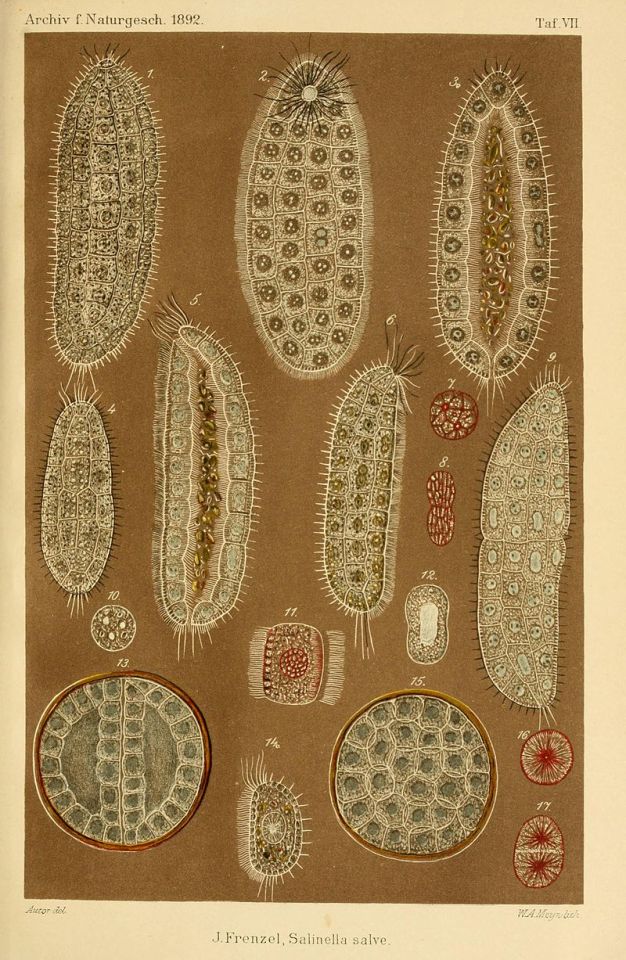
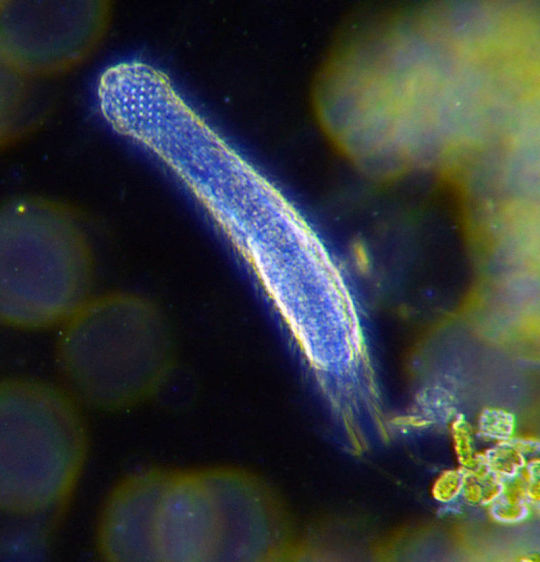
Monoblastozoa. This phylum of animals has only one member, Salinella salve, which was only ever described in the 1890s and hasn't been found since.
Gastrotrich. This phylum is made up of microscopic aquatic animals that mostly live in waterbeds and feed on detritus
#animals#biology#polls#poll tournament#zoology#lost media#spiralia#Monoblastozoa#Gastrotrich#0x31v0x4e
84 notes
·
View notes
Text

Sometimes the animals are really jazzed to be in the SEM.
(specimen in picture is the gastrotrich Xenodasys riedlii)
@bogleech
1 note
·
View note
Text
They're winners to me...

Round 1 - Phylum Gastrotricha

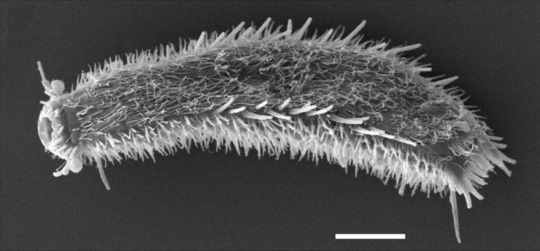


(Sources - 1, 2, 3, 4)
The Phylum Gastrotricha, animals commonly referred to as hairybellies or hairybacks, are a group of microscopic, cylindrical animals.
They are widely distributed and abundant in both freshwater and marine environments, though some species can be found on land living in the film of water surrounding grains of soil. Though simple, they have a head region, with a brain and sensory organs, and a trunk with a simple gut and reproductive organs. They anchor themselves to the substrate via adhesive glands and use cilia (said “hair”) to move around. They feed on detritus and have a lifespan of just a few days. Nearly 800 species of gastrotrich have been described.

Propaganda under the cut:
Fertilized eggs leave their parents by bursting out through the skin, which then repairs itself. Pretty metal tbh
Some species are capable of laying eggs that remain dormant during times when the young would be unlikely to survive, but are also capable of laying normal eggs in times of plenty.
Baby gastrotrichs just look like miniature adults (or, miniature miniature adults), and reach sexual maturity in about three days.
One species has lived up to 40 days in a lab, producing 4-5 eggs during the first 10 days of its life.
Basically a whole phylum dedicated to living fast and dying young
Idk they’re kinda cute
221 notes
·
View notes
Text
Assigning microorganisms to the marauders era characters because I'm mentally unwell
Remus:
Gastrotrich (is it just because they look furry? Yes)

Sirius:
He's kind of a tardigrade tbh

James:
He's such a rotifer

Peter:
Absolutely a paramecium

Lily:
A gorgeous gorgeous desmid

Pandora:
Honestly also a desmid (Pandalily soulmate behaviour)

Regulus:
Hydra. (My reasoning is way too deep compared to the others it's embarrassing)

Barty:
He's a stentor, good for him

Evan:
He's also a tardigrade I reckon

Marlene:
Ohhhh rotiferrrrr

Will be continuing in a reblog 😌
#marauders era#pandalily#lily evans#regulus black#dorcas meadowes#slytherin skittles#marlene mckinnon#pandora lovegood#remus lupin#sirius black#james potter#peter pettigrew#pandora rosier#barty crouch jr#evan rosier#barty crouch junior#the marauders
47 notes
·
View notes
Text
Phylum #23: Gastrotricha, the hairybellies!
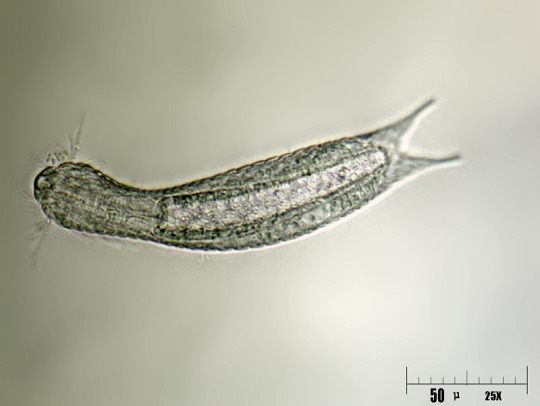
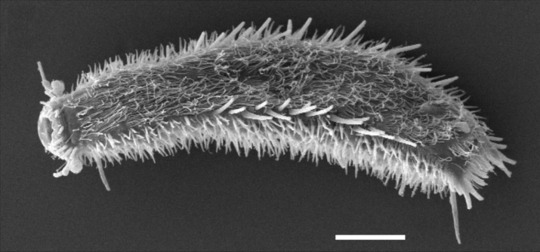
One more phylum of meiofauna, microscopic critters living in interstitial spaces! At most a few millimeters but often much smaller, hairybellies are named after the many cilia on their flat ventral surface!
These cilia work in tandem with adhesive tubes - especially on their characteristic forked tail, with which they crawl and slide inbetween sediments to eat, well, the kind of food a tiny guy would eat. Diatoms, bacteria and various kinds of organic matter are on the menu!
As often with these tiny critters, the rest of the body is quite simple - no circulatory or respiratory system, although a roughly differentiated head is visible. The latter often bears sensory cilia - microscopic whiskers! And they have scales covering their back - which is pretty unexpected for an animal that tiny!
Living gastrotrichs are divided in two groups. The chaetonotids have successfully reached both marine and freshwater environments, while macrodasyids stayed mostly marine, but developed two pores on either side of the neck, through which they shoot out water while eating. While extremely commonplace in today's sediments, they unfortunately lack a fossil record, making their relationship with other phyla yet more mysterious!
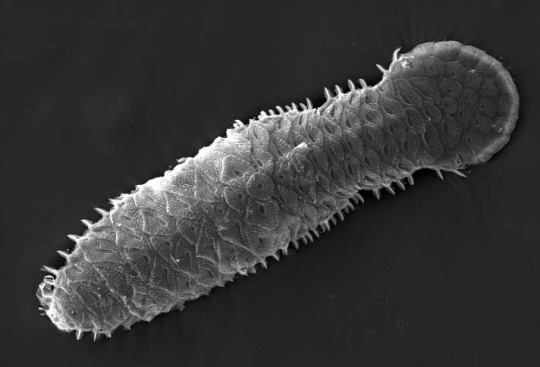
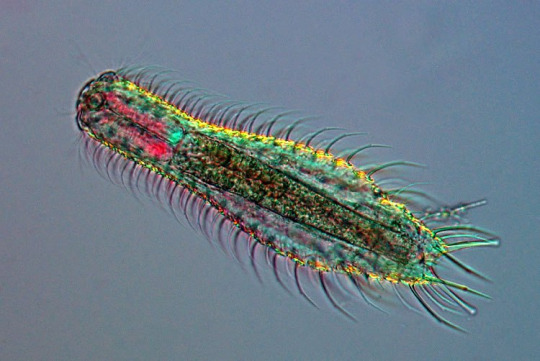
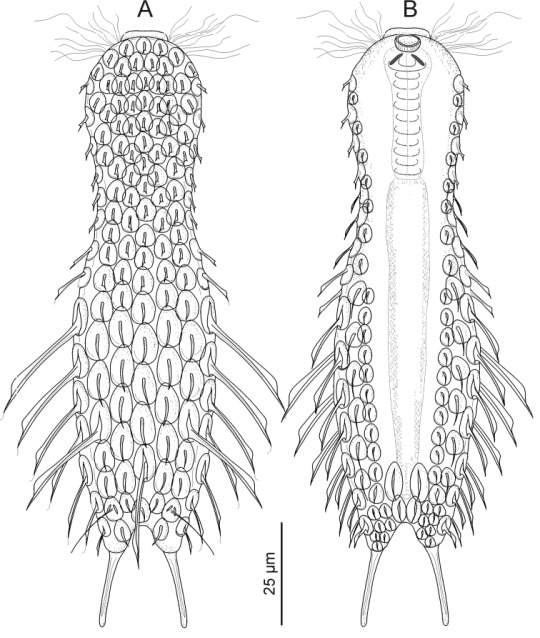
#forms and phyla#gastrotricha#hairybelly#hairy belly#taxonomy#meiofauna#meioblr#that should be a tag
38 notes
·
View notes
Note
I must now know your opinion on whether the following organisms are bugs.
Dinocaridids? Hydra? Sponges? Bryozoa? Rotifers and tardigrades are definitely bugs, but are gastrotrichs? Slime molds? I would reckon that flagellated or otherwise motile algae are definitely bugs.
I wonder as well if there is a certain maximum size limit to be a bug. My mind goes to the widest of tarantulas, but I've seen puffball mushrooms bigger than that. What characteristics do you associate with bug-ness?
every thing you mentioned is a bug
32 notes
·
View notes
Text
AND NOW, ALL BEASTS, IN ORDER CATEGORICAL!
NON-BEASTLY BEASTS:
Non-ParaHoxozoa:
Calcarea (Calcareous Sponges)
Hexacinellida (Glass Sponges)
Demospongiae (Demosponges)
Tentaculata (Tentacled Ctenophores)
Beroida (Non-Tentacled Ctenophores)
ParaHoxozoa, Non-Nephrozoa:
Placozoa
Anthozoa (Corals, Sea Pens, and Tube-Dwelling Anenomes)
Medusozoa (Jellyfish and Hydrozoans)
Myxozoa
Xenacoelomorpha
MINIBEASTS:
Spiralia, Non-Lophotrochozoa:
Gnathifera (Rotifers and Jaw Worms)
Mesozoa
Rouphozoa (Flatworms and Gastrotrichs)
Lophotrochozoa, Non-Mollusca:
Cycliophora
Annelida (Segmented Worms)
Nemertea (Ribbon Worms)
Bryozoa
Entoprocta
Phorodina (Horseshoe Worms)
Brachiopoda
Mollusca:
Solenogastres
Caudofoveata
Polyplacophora (Chitons)
Bivalvia (Clams, Scallops, Mussels, Oysters, Cockles, and others)
Monoplacophora
Scaphopoda (Tusk Shells)
Gastropoda (Snails, Slugs, Sea Snails, Sea Slugs, and others)
Cephalopoda (Nautiloids, Cuttlefish, Squid, and Octopi)
Ecdysozoa, Non-Arthropoda:
Loricifera
Priapulida (Penis Worms [sic])
Kinorhyncha (Mud Dragons)
Nematoda (Roundworms)
Nematomorpha (Horsehair Worms)
Tardigrada (Tardigrades)
Onchyophora (Velvet Worms)
Arthropoda, Non-Mandibulata:
Pycnogonida (Sea Spiders)
Xiphosura (Horseshoe Crabs)
Acariformes (Cheese Mites, Scabies Mites, Eyelash Mites, House Mites, and others)
Opiliones (Harvestmen)
Ricinulei (Hooded Tickspiders)
Solifugae (Camel Spiders)
Parisitiformes (Ticks, Varroa Mites, and others)
Pseudoscorpiones (Pseudoscorpions)
Scorpiones (Scorpions)
Araneae (Spiders)
Amblypigi (Whip Spiders)
Urgopygi (Whip Scorpions)
Mandibulata, Non-Insecta:
Chilopoda (Centipedes)
Symphyla (Pseudocentipedes)
Pauropoda
Diplopoda (Millipedes)
Ostracoda (Seed Shrimp)
Mystacocarida
Branchiura (Fish Lice)
Pentastomida (Tongue Worms)
Copepoda (Copepods)
Tantulocarida
hecostraca (Barnacles and others)
Malacostraca (Crabs, Lobsters, Shrimp, Isopods, Amphipods, and others)
Cephalocarida (Horseshoe Shrimp)
Branchiopoda (Fairy Shrimp, Tadpole Shrimp, Water Fleas, and others)
Remipedia
Collembola (Springtails)
Protura
Diplura (Two-Pronged Bristletails)
Insecta, Non-Neoptera:
Archaeognatha (Jumping Bristletails)
Zygentoma (Silverfish, Firebrats, and others)
Odonatoptera (Dragonflies and Damselflies)
Ephemeroptera (Mayflies)
Neoptera, Non-Holometabola:
Zoraptera (Angel Insects)
Dermaptera (Earwigs)
Plecoptera (Stoneflies)
Orthoptera (Grasshoppers, Crickets, and others)
Mantodea (Mantises)
Blattodea (Cockroaches and Termites)
Notoptera (Ice Crawlers and Rock Crawlers)
Phasmatodea (Stick Insects and Leaf Insects)
Embioptera (Webspinners)
Psocodea (Lice)
Hemiptera (Shield Bugs, Aphids, Scale Insects, Cicadas, Planthoppers, Assassin Bugs, Water Boatmen, Pond Skaters, and others)
Thysanoptera (Thrips)
Holometabola:
Hymenoptera (Sawflies, Bees, Wasps, and Ants)
Strepsiptera
Coleoptera (Beetles)
Raphidioptera (Snakeflies)
Neuroptera (Lacewings, Antlions, and others)
Megaloptera (Dobsonflies and others)
Lepidoptera (Butterflies and Moths)
Trichoptera (Caddisflies)
Diptera (Flies, Mosquitoes, Gnats, Midges, Hoverflies, and others)
Mecopteroidea (Scorpionflies, Hangingflies, and Fleas)
SLIGHTLY MORE BEASTLY BEASTS:
Ambulacraria:
Echinodermata (Starfish, Sea Urchins, Brittle Stars, Feather Stars, and others)
Hemichordata (Acorn Worms and others)
Chordata (Non-Vertebrata):
Leptocardii (Lancelets)
Tunicata (Sea Squirts, Salps, Pyrosomes, and others)
Vertebrata (Non-Eutelostomi):
Myxini (Hagfish)
Hyperoartia (Lampreys)
Elasmobranchii (Sharks, Rays, and Skates)
Holocephali (Chimaeras)
Actinopterygii (Non-Acanthomorpha):
Cladistia (Bichirs and Reedfish)
Acnipenseriformes (Paddlefish and Sturgeons)
Halecomorphi (Bowfins)
Ginglymodi (Gars)
Elopocephalai (Eels, Ladyfish, Halosaurs, and others)
Osteoglossocephala (Arapaima, Goldeye, and others)
Clupei (Herrings and Anchovies)
Apelocephali (Slickheads and others)
Anotophysa (Milkfish, Beaked Salmon, and others)
Cypriniformes (Carp, Goldfish, Loaches, Minnows, and others)
Characiformes (Characins, Pacu, Pirahnas, Tetras, and others)
Gymnotiformes (Knifefish and Electric Eels)
Siluriformes (Catfish)
Lepidogalaxii (Salamanderfish)
Protacanthopterygii (Salmon, Pike, Trout, Barreleye, and others)
Stomiati (Smelts, Marine Hatchetfish, and others)
Ateleopodia (Jellynose Fish)
Aulopa (Bombay Duck and Lancetfish)
Myctophata (Lanternfish)
Acanthomorpha:
Lampridacea (Oarfish, Opah and others)
Paracanthomorphacea (Cods, Dories, Cavefish, and others)
Polymixiacea (Beardfish)
Berycimorphaceae (Fangtooths, Pineconefishes, and others)
Holocentrimorphaceae (Soldierfish)
Ophidiiformes (Pearlfish)
Batrachoidimophara (Toadfish)
Gobiomorpharia (Seahorses, Pipefish, Tunas, Flying Gurnards, and others)
Anabantaria (Gouramis, Swamp Eels, and others)
Carangaria (Swordfish, Flatfish, Remoras, and others)
Ovalentaria (Blennies, Cichlids, Flying Fish, Mullets, and others)
Eupercaria (Anglerfish, Pufferfish, Wrasses, Sunfish, Sticklebacks, Lumpsuckers, Lionfish, Angelfish, Perches, Archerfish, Triggerfish, Bass, and others)
Sarcopterygii:
Actinistia (Coelocanths)
Dipnoi (Lungfish)
BEASTS PROPER:
Lissamphibia:
Salientia (Frogs and Toads)
Caudata (Salamanders and Newts)
Gymnophiona (Caecilians)
Reptilia (Non-Aves):
Rhynchocephalia (Tuatara)
Dibamidae (Blind Skinks)
Gekkota (Geckos and Flap-Footed Lizards)
Scinciformata (Skinks and others)
Laterata (Tegus and Worm Lizards)
Anguimorpha (Slow Worms, Monitors, Gila Monster, and others)
Iguania (Anoles, Iguanas, Chameleons, and others)
Serpentes (Snakes)
Testudines (Turtles and Tortoises)
Crocodilia (Crocodiles, Gharials, Alligators, and Caiman)
Aves (Non-Passeriformes):
Palaeognathae (Ostriches, Kiwis, and others)
Galloanserae (Chickens, Ducks, and others)
Mirandornithes (Flamingos and Grebes)
Columbimorphae (Doves and others)
Otidimorphae (Cuckoos, Turacos, and Bustards)
Gruimorphae (Gulls, Cranes, Auks, and others)
Ophistocomidae (Hoatzins)
Strisores (Hummingbirds, Nightjars, Potoos, and others)
Phaethoquornithes (Boobies[sic], Loons, Ibises, Penguins, Albatrosses, Tropicbirds, and others)
Acciptirimorphae (Vultures, Hawks, Eagles, and others)
Strigiformes (Owls)
Coraciimorphae (Kingfishers, Woodpeckers, Quetzals, and others)
Cariamiformes (Seriemas)
Falconiformes (Falcons)
Psittaciformes (Parrots)
Passeriformes:
Acanthisitti (New Zealand Wrens)
Tyranni (Overnbirds, Spadebills, Gnateaters, and others)
Menurida (Lyrebirds and others)
Climacterida (Bowerbirds and others)
Meliphagida (Honeyeaters, Bristlebirds, and others)
Orthonychida (Logrunners and others)
Corvides (Crows, Jays, Boatbills, Shriketits, Sittellas, Birds-Of-Paradise and others)
Passerides (Satinbirds, Sparrows, Larks, Tits[sic], Oxpeckers, Thrushes, Wrens, Finches, Tanagers, Nuthatchers, and others)
Mammalia (Non-Laurasiatheria):
Monotremata (Platypus and Echidnas)
Marsupialia (Kangaroos, Opossums, Wombats, and others)
Xenarthra (Anteaters, Sloths, and others)
Athrotheria (Elephants, Manatees, Aardvarks, and others)
Lagomorpha (Rabbits, Hares and others)
Rodentia (Mice, Rats, Cavies, Beavers, Squirrels, and others)
Scandentia (Treeshrews)
Dermoptera (Colugos)
Primates (Lemurs, Marmosets, Baboons, Gibbons, Chimpanzees, and others)
Lauasiatheria (Non-Carnivora):
Eulipotyphla (Shrews, Moles, Hedgehogs, and others)
Chiroptera (Bats)
Artiodactyla (Girrafes, Deer, Whales, Pigs, Camels, and others)
Perissodactyla (Horses, Tapirs, and Rhinoceroses)
Pholidota (Pangolins)
Carnivora:
Viverroidea (Hyenas, Mongooses, Civets, and others)
Feloidea (Lions, Tigers, Caracals, Wildcats, Leopards, and others)
Nandiniidae (African Palm Civet)
Caninae (Wolves, Foxes, and others)
Ursidae (Bears)
Musteloidea (Skunks, Weasels, Otters, Raccoons, and others)
Pinnipedia (Seals, Sea Lions, and Walruses)

16K notes
·
View notes
Text
Multiple Displacement Amplification Facilitates SMRT Sequencing of Microscopic Animals and the Genome of the Gastrotrich Lepidodermella squamata (Dujardin, 1841)
http://dlvr.it/T1fGdw
0 notes
Text
Taxonomy Tournament: Spiralia


Cycliophora. This phylum is made of tiny commensal animals found attached to the mouthparts of lobsters.
Gastrotrich. This phylum is made up of microscopic aquatic animals that mostly live in waterbeds and feed on detritus
#animals#biology#polls#poll tournament#zoology#spiralia#Cycliophora#Gastrotrich#0x4ev0xb1#animal tournament#Animal Tournament Round 1
59 notes
·
View notes
Text






"In our bodies, we turn to kidneys to filter out toxins and ammonia waste while reabsorbing metabolites. What doesn't get reabsorbed gets released as urine. But even simpler organisms need to be able to regulate the water and metabolites inside them. For one, water is a physical thing: it takes up space and creates pressure inside a cell, which is good... up until a point.... And once you get past that point, organisms can end up bursting.... Aside from the terrifying thought that you could water yourself into bursting, there's the matter of maintaining the right balance of life-sustaining molecules and getting rid of waste."
Journey to the Microcosmos- How Do Microorganisms Pee?
Images Originally Captured by Jam's Germs
#journey to the microcosmos#How Do Microorganisms Pee?#science#scienceblr#bioblr#biology#microbiology#microorganisms#microbes#kidney tissue#gastrotrich#single celled organism#science aesthetic
69 notes
·
View notes
Text
Gastrotrichs (hairybacks) are grandmas at 4 days old

10K notes
·
View notes
Text
Round 1 - Phylum Gnathostomulida




(Sources - 1, 2, 3, 4)
Gnathostomulida is a small phylum of small marine animals commonly called Jaw Worms. They live in the sand and mud of shallow, coastal waters, gliding between grains of sand. They can be 0.5 to 1 millimetre in length and are slender or thread-like, and generally transparent.
Gnathostomulids have no circulatory or respiratory system and a simple nervous system. Their only sense organs are cilia used for sensing vibrations, clustered around the head region. Their mouth is behind the head, on underside of the body, and has a pair of cuticle jaws (seen in the 4th image) supplied by strong muscles. Most species also have small teeth. They use these jaws to feed on bacteria, protists, and fungi they find within the sediment. All species are hermaphroditic. Like gastrotrichs, their fertilized eggs will simply burst out through their parents’ skin which then repairs itself. The egg will hatch into a miniature version of the adult, with no larval stage.

Propaganda under the cut:
One order, the bursovaginoids, are characterized by the presence of a penis. That’s just a fun thing to know, imo.
Tiny worms with teeth
21 notes
·
View notes
Text

🌊🌊 🐚 BENTHIARY 🐚 🌊🌊 day 19-20 I forgot to mention but starting from the previous monstrilloida, Benthiary is getting more microscopic lol. Here's one of them: gastrotrich! They're named for their hairy appearance and they have a whole brain which is kinda amazing. One species all produces eggs and breeds asexually within 4 days of living! Gastrotrich comes in many shapes but generally I wanted to do a stylized design from their most defining characteristics. I think they look like batik patterns come to live. Also, I started watching Journey to the Microcosmos on Youtube while drawing this. I'm gonna binge all episodes now lol.



#art#art photography#benthiary#benthos#marine life#marine art#sea life#sea creatures#marine biology#gastrotrich#sketchbook#sketchbook art#art journal#drawing#illustration#botanical illustration#traditional illustration#scientific illustration#color pencils#ink illustration#artists on tumblr#illustrators on tumblr#black and white#ocean aesthetic#sea aesthetic#traditional art#traditional drawing#art prompt#drawing prompt
7 notes
·
View notes
Text

instagram


0 notes
Text
don't fucking challenge me i know every beast
NON-BEASTLY BEASTS:
Non-ParaHoxozoa:
Calcarea (Calcareous Sponges)
Hexacinellida (Glass Sponges)
Demospongiae (Demosponges)
Tentaculata (Tentacled Ctenophores)
Beroida (Non-Tentacled Ctenophores)
ParaHoxozoa, Non-Nephrozoa:
Placozoa
Anthozoa (Corals, Sea Pens, and Tube-Dwelling Anenomes)
Medusozoa (Jellyfish and Hydrozoans)
Myxozoa
Xenacoelomorpha
MINIBEASTS:
Spiralia, Non-Lophotrochozoa:
Gnathifera (Rotifers and Jaw Worms)
Mesozoa
Rouphozoa (Flatworms and Gastrotrichs)
Lophotrochozoa, Non-Mollusca:
Cycliophora
Annelida (Segmented Worms)
Nemertea (Ribbon Worms)
Bryozoa
Entoprocta
Phorodina (Horseshoe Worms)
Brachiopoda
Mollusca:
Solenogastres
Caudofoveata
Polyplacophora (Chitons)
Bivalvia (Clams, Scallops, Mussels, Oysters, Cockles, and others)
Monoplacophora
Scaphopoda (Tusk Shells)
Gastropoda (Snails, Slugs, Sea Snails, Sea Slugs, and others)
Cephalopoda (Nautiloids, Cuttlefish, Squid, and Octopi)
Ecdysozoa, Non-Arthropoda:
Loricifera
Priapulida (Penis Worms [sic])
Kinorhyncha (Mud Dragons)
Nematoda (Roundworms)
Nematomorpha (Horsehair Worms)
Tardigrada (Tardigrades)
Onchyophora (Velvet Worms)
Arthropoda, Non-Mandibulata:
Pycnogonida (Sea Spiders)
Xiphosura (Horseshoe Crabs)
Acariformes (Cheese Mites, Scabies Mites, Eyelash Mites, House Mites, and others)
Opiliones (Harvestmen)
Ricinulei (Hooded Tickspiders)
Solifugae (Camel Spiders)
Parisitiformes (Ticks, Varroa Mites, and others)
Pseudoscorpiones (Pseudoscorpions)
Scorpiones (Scorpions)
Araneae (Spiders)
Amblypigi (Whip Spiders)
Urgopygi (Whip Scorpions)
Mandibulata, Non-Insecta:
Chilopoda (Centipedes)
Symphyla (Pseudocentipedes)
Pauropoda
Diplopoda (Millipedes)
Ostracoda (Seed Shrimp)
Mystacocarida
Branchiura (Fish Lice)
Pentastomida (Tongue Worms)
Copepoda (Copepods)
Tantulocarida
Thecostraca (Barnacles and others)
Malacostraca (Crabs, Lobsters, Shrimp, Isopods, Amphipods, and others)
Cephalocarida (Horseshoe Shrimp)
Branchiopoda (Fairy Shrimp, Tadpole Shrimp, Water Fleas, and others)
Remipedia
Collembola (Springtails)
Protura
Diplura (Two-Pronged Bristletails)
Insecta, Non-Neoptera:
Archaeognatha (Jumping Bristletails)
Zygentoma (Silverfish, Firebrats, and others)
Odonatoptera (Dragonflies and Damselflies)
Ephemeroptera (Mayflies)
Neoptera, Non-Holometabola:
Zoraptera (Angel Insects)
Dermaptera (Earwigs)
Plecoptera (Stoneflies)
Orthoptera (Grasshoppers, Crickets, and others)
Mantodea (Mantises)
Blattodea (Cockroaches and Termites)
Notoptera (Ice Crawlers and Rock Crawlers)
Phasmatodea (Stick Insects and Leaf Insects)
Embioptera (Webspinners)
Psocodea (Lice)
Hemiptera (Shield Bugs, Aphids, Scale Insects, Cicadas, Planthoppers, Assassin Bugs, Water Boatmen, Pond Skaters, and others)
Thysanoptera (Thrips)
Holometabola
Hymenoptera (Sawflies, Bees, Wasps, and Ants)
Strepsiptera
Coleoptera (Beetles)
Raphidioptera (Snakeflies)
Neuroptera (Lacewings, Antlions, and others)
Megaloptera (Dobsonflies and others)
Lepidoptera (Butterflies and Moths)
Trichoptera (Caddisflies)
Diptera (Flies, Mosquitoes, Gnats, Midges, Hoverflies, and others)
Mecopteroidea (Scorpionflies, Hangingflies, and Fleas)
SLIGHTLY MORE BEASTLY BEASTS:
Ambulacraria:
Echinodermata (Starfish, Sea Urchins, Brittle Stars, Feather Stars, and others)
Hemichordata (Acorn Worms and others)
Chordata (Non-Vertebrata):
Leptocardii (Lancelets)
Tunicata (Sea Squirts, Salps, Pyrosomes, and others)
Vertebrata (Non-Eutelostomi):
Myxini (Hagfish)
Hyperoartia (Lampreys)
Elasmobranchii (Sharks, Rays, and Skates)
Holocephali (Chimaeras)
Actinopterygii (Non-Acanthomorpha):
Cladistia (Bichirs and Reedfish)
Acnipenseriformes (Paddlefish and Sturgeons)
Halecomorphi (Bowfins)
Ginglymodi (Gars)
Elopocephalai (Eels, Ladyfish, Halosaurs, and others)
Osteoglossocephala (Arapaima, Goldeye, and others)
Clupei (Herrings and Anchovies)
Apelocephali (Slickheads and others)
Anotophysa (Milkfish, Beaked Salmon, and others)
Cypriniformes (Carp, Goldfish, Loaches, Minnows, and others)
Characiformes (Characins, Pacu, Pirahnas, Tetras, and others)
Gymnotiformes (Knifefish and Electric Eels)
Siluriformes (Catfish)
Lepidogalaxii (Salamanderfish)
Protacanthopterygii (Salmon, Pike, Trout, Barreleye, and others)
Stomiati (Smelts, Marine Hatchetfish, and others)
Ateleopodia (Jellynose Fish)
Aulopa (Bombay Duck and Lancetfish)
Myctophata (Lanternfish)
Acanthomorpha:
Lampridacea (Oarfish, Opah and others)
Paracanthomorphacea (Cods, Dories, Cavefish, and others)
Polymixiacea (Beardfish)
Berycimorphaceae (Fangtooths, Pineconefishes, and others)
Holocentrimorphaceae (Soldierfish)
Ophidiiformes (Pearlfish)
Batrachoidimophara (Toadfish)
Gobiomorpharia (Seahorses, Pipefish, Tunas, Flying Gurnards, and others)
Anabantaria (Gouramis, Swamp Eels, and others)
Carangaria (Swordfish, Flatfish, Remoras, and others)
Ovalentaria (Blennies, Cichlids, Flying Fish, Mullets, and others)
Eupercaria (Anglerfish, Pufferfish, Wrasses, Sunfish, Sticklebacks, Lumpsuckers, Lionfish, Angelfish, Perches, Archerfish, Triggerfish, Bass, and others)
Sarcopterygii:
Actinistia (Coelocanths)
Dipnoi (Lungfish)
BEASTS PROPER:
Lissamphibia
Salientia (Frogs and Toads)
Caudata (Salamanders and Newts)
Gymnophiona (Caecilians)
Reptilia (Non-Aves)
Rhynchocephalia (Tuatara)
Dibamidae (Blind Skinks)
Gekkota (Geckos and Flap-Footed Lizards)
Scinciformata (Skinks and others)
Laterata (Tegus and Worm Lizards)
Anguimorpha (Slow Worms, Monitors, Gila Monster, and others)
Iguania (Anoles, Iguanas, Chameleons, and others)
Serpentes (Snakes)
Testudines (Turtles and Tortoises)
Crocodilia (Crocodiles, Gharials, Alligators, and Caiman)
Aves (Non-Passeriformes):
Palaeognathae (Ostriches, Kiwis, and others)
Galloanserae (Chickens, Ducks, and others)
Mirandornithes (Flamingos and Grebes)
Columbimorphae (Doves and others)
Otidimorphae (Cuckoos, Turacos, and Bustards)
Gruimorphae (Gulls, Cranes, Auks, and others)
Ophistocomidae (Hoatzins)
Strisores (Hummingbirds, Nightjars, Potoos, and others)
Phaethoquornithes (Boobies, Loons, Ibises, Penguins, Albatrosses, Tropicbirds, and others)
Acciptirimorphae (Vultures, Hawks, Eagles, and others)
Strigiformes (Owls)
Coraciimorphae (Kingfishers, Woodpeckers, Quetzals, and others)
Cariamiformes (Seriemas)
Falconiformes (Falcons)
Psittaciformes (Parrots)
Passeriformes:
Acanthisitti (New Zealand Wrens)
Tyranni (Overnbirds, Spadebills, Gnateaters, and others)
Menurida (Lyrebirds and others)
Climacterida (Bowerbirds and others)
Meliphagida (Honeyeaters, Bristlebirds, and others)
Orthonychida (Logrunners and others)
Corvides (Crows, Jays, Boatbills, Shriketits, Sittellas, Birds-Of-Paradise and others)
Passerides (Satinbirds, Sparrows, Larks, Tits, Oxpeckers, Thrushes, Wrens, Finches, Tanagers, Nuthatchers, and others)
Mammalia (Non-Laurasiatheria):
Monotremata (Platypus and Echidnas)
Marsupialia (Kangaroos, Opossums, Wombats, and others)
Xenarthra (Anteaters, Sloths, and others)
Athrotheria (Elephants, Manatees, Aardvarks, and others)
Lagomorpha (Rabbits, Hares and others)
Rodentia (Mice, Rats, Cavies, Beavers, Squirrels, and others)
Scandentia (Treeshrews)
Dermoptera (Colugos)
Primates (Lemurs, Marmosets, Baboons, Gibbons, Chimpanzees, and others)
Lauasiatheria (Non-Carnivora):
Eulipotyphla (Shrews, Moles, Hedgehogs, and others)
Chiroptera (Bats)
Artiodactyla (Girrafes, Deer, Whales, Pigs, Camels, and others)
Perissodactyla (Horses, Tapir, and Rhinoceros)
Pholidota (Pangolins)
Carnivora:
Viverroidea (Hyenas, Mongooses, Civets, and others)
Feloidea (Lions, Tigers, Caracals, Wildcats, Leopards, and others)
Nandiniidae (African Palm Civet)
Caninae (Wolves, Foxes, and others)
Ursidae (Bears)
Musteloidea (Skunks, Weasels, Otters, Raccoons, and others)
Pinnipedia (Seals, Sea Lions, and Walruses)

Interview questions for gym leaders
4K notes
·
View notes
Note
Would you mind putting your worm phyla poem in it’s own post for ease of reblogging/reading? It seems like it’d be fun to memorize!

Gather round and get to know a
List of all the Metazoa
All the world’s countless creatures
Organized by body features
Classified with closest kin.
We call them Phyla. Let’s begin!
Porifera, amorphous things;
Cnidaria, equipped with stings
that help them as they feed and fight;
Symbion who clings on tight
to lobster mouthparts where it dwells;
Brachiopods with sideways shells;
Little wiggly Kinorhynchs;
and we’re still working out the kinks
with Xenacoelomorphs, but they
invented left and right, some say.
Spiny skinned Echinoderms;
and all the seething hordes of worms:
Horsheshoes, Horsehairs, Nematodes,
Nemerteans - we’ve got loads!
Predator Chaetognatha,
Muddy Priapulida,
Jaw-worms never cause a fuss
but Hemichordates grow like us!
Thorny-heads and Gastrotrichs;
Velvet Worms with silk that sticks;
Entoprocta wreathed in cilia;
Annelids, the most familiar;
Flatworms with no cavities.
Now onto others, unlike these -
Ctenophores propelled by combs;
Mollusks in their hardened homes;
and in that group, the guts of squids
may play host to Dicyemids.
The tiny hardy Tardigrade;
Placozoa simply made;
Loricifera in gravel;
Orthonecta who unravel
when their larval stage is done.
Limnognathia, only one.
Rotifera, not really spinning;
Arthropods (I think they’re winning);
Bryozoa, never lonely;
Chordates, tough and quick and bony.
That the last is where we fit,
But we’ve a place in all of it.
From corals, clams, and brittle stars
To frogs and birds and us and ours
We all share common ancestry
to one small cell beneath the sea,
adrift in space around the sun:
the Family of Everyone!
2K notes
·
View notes